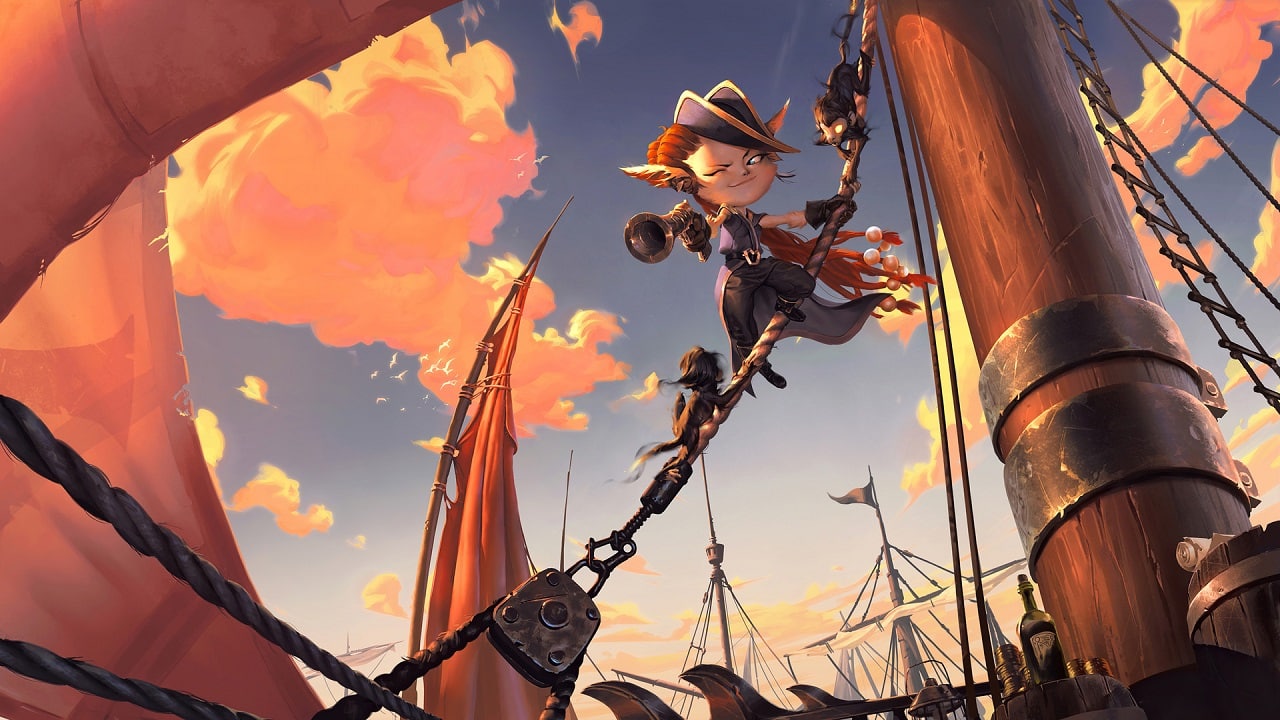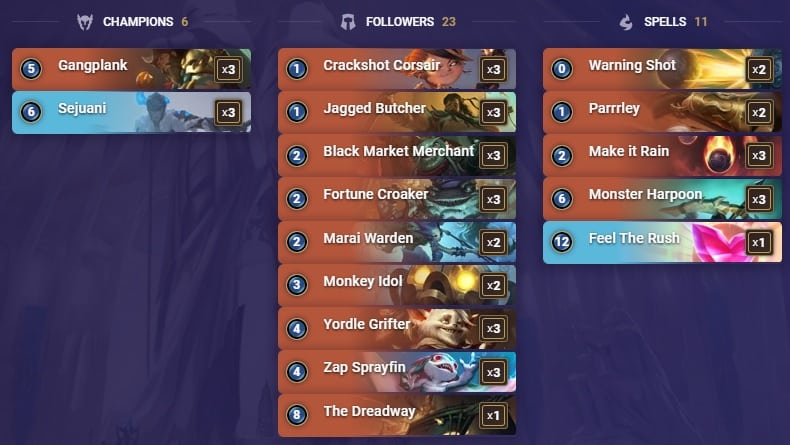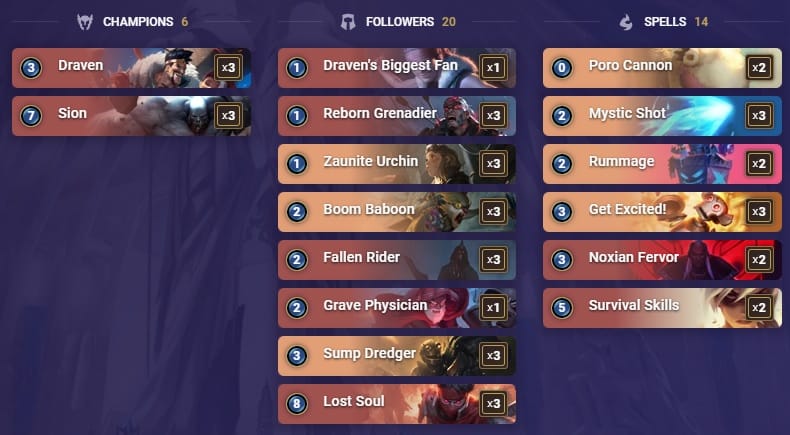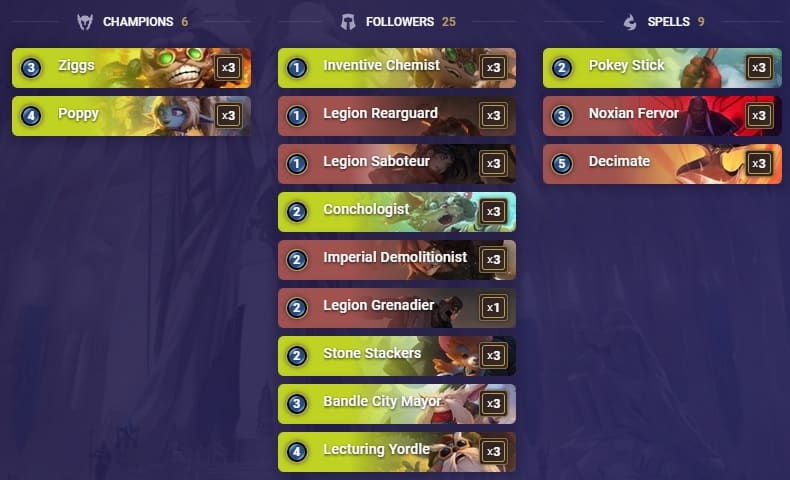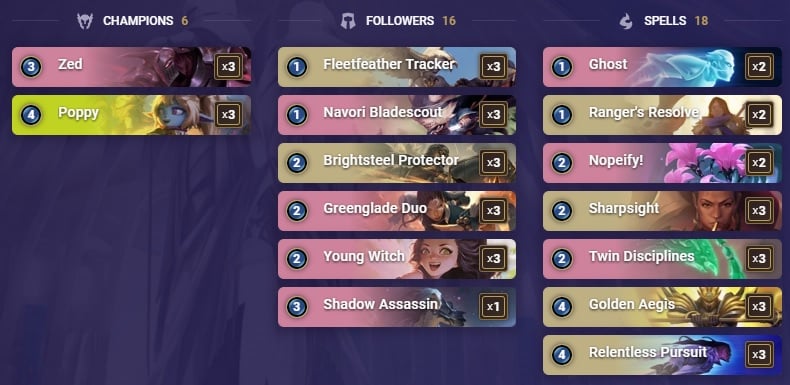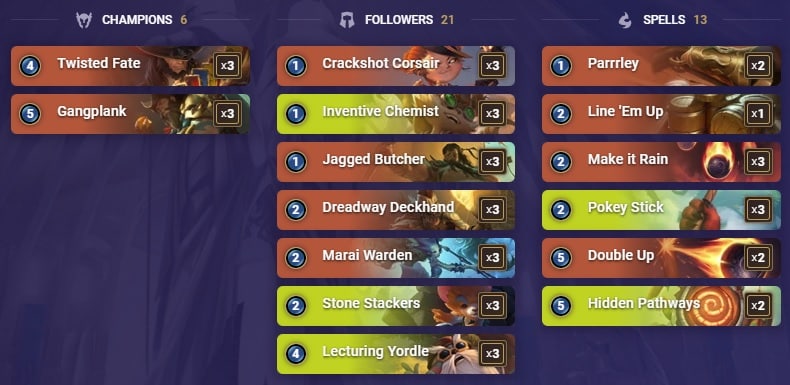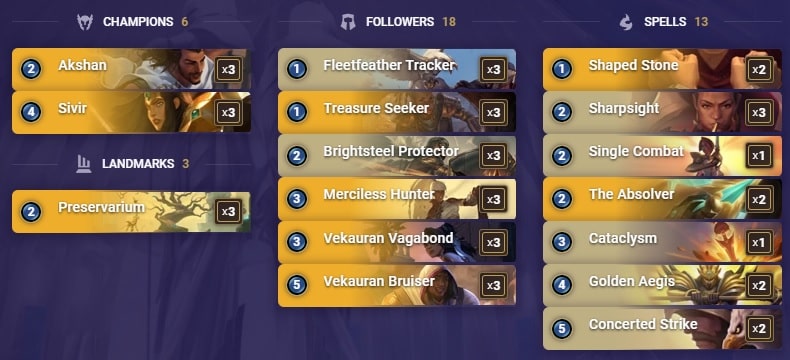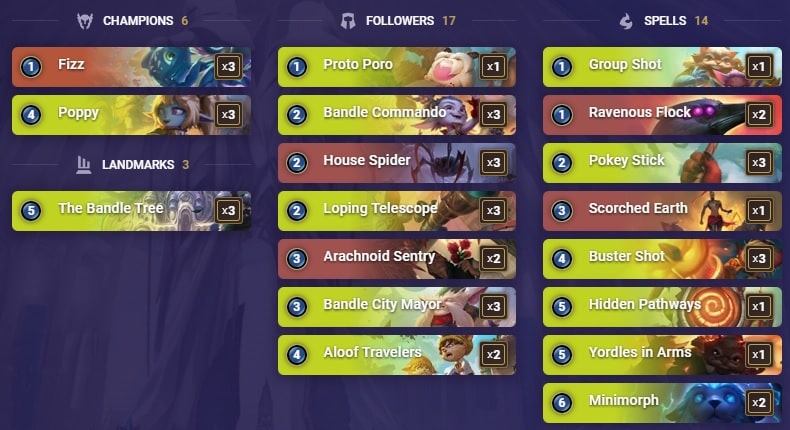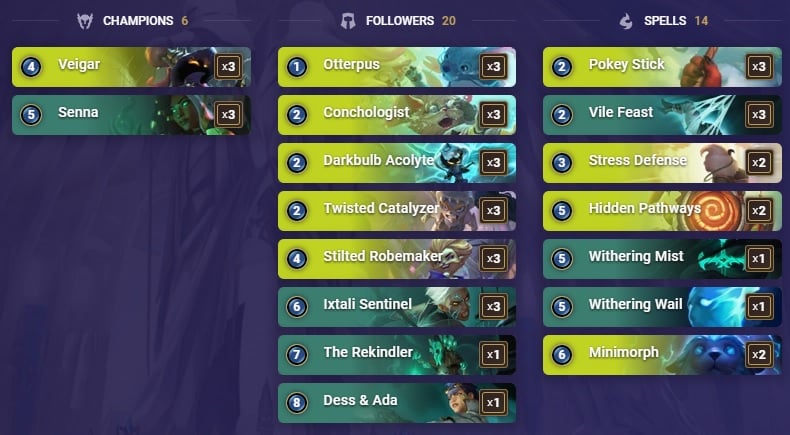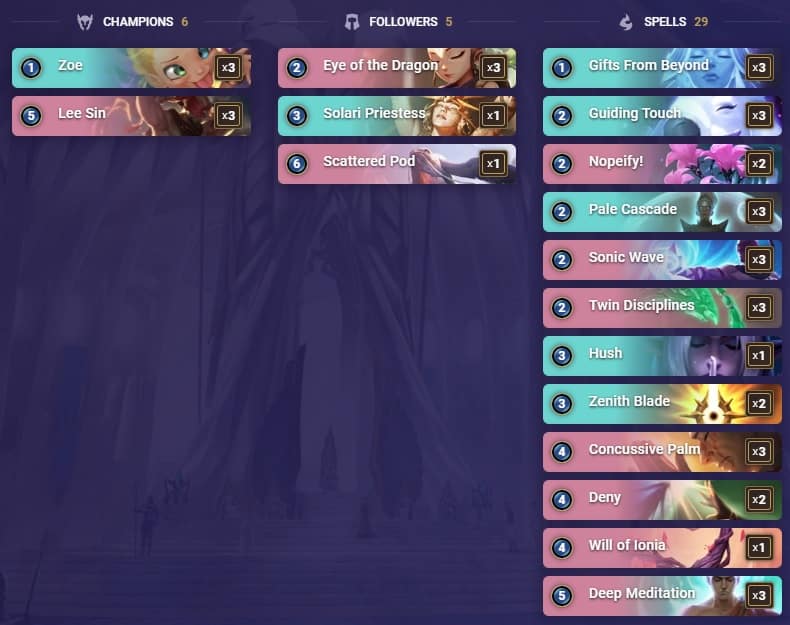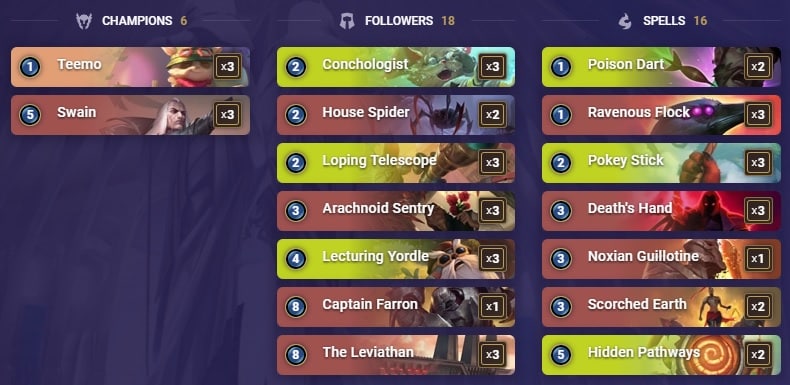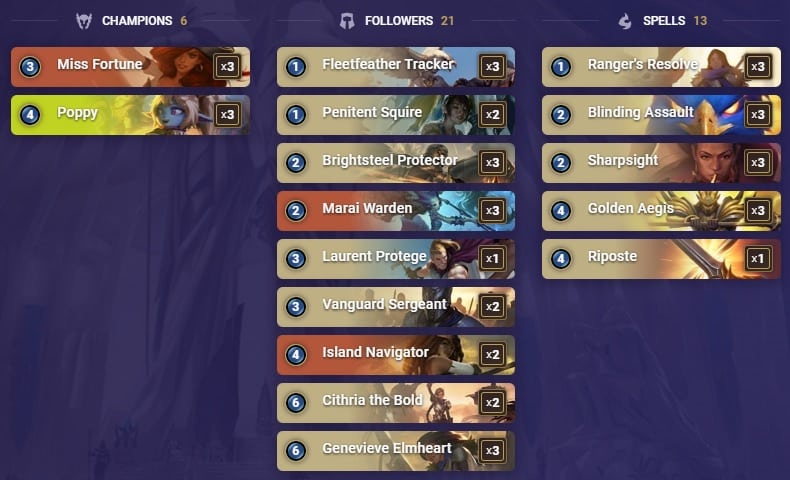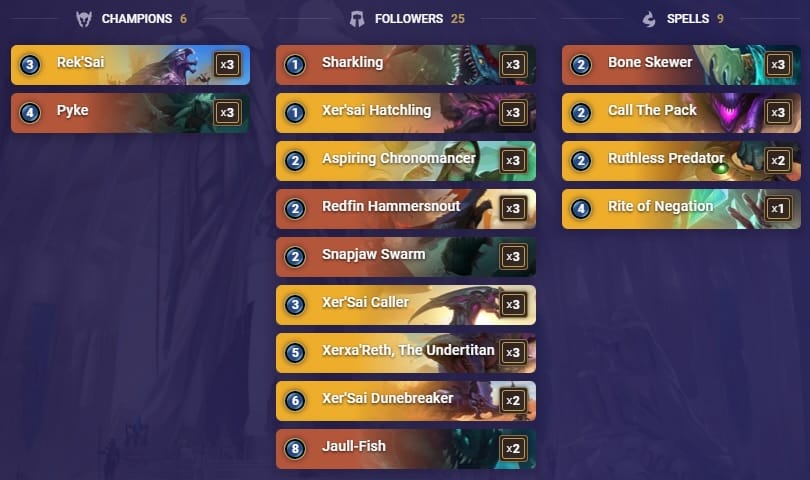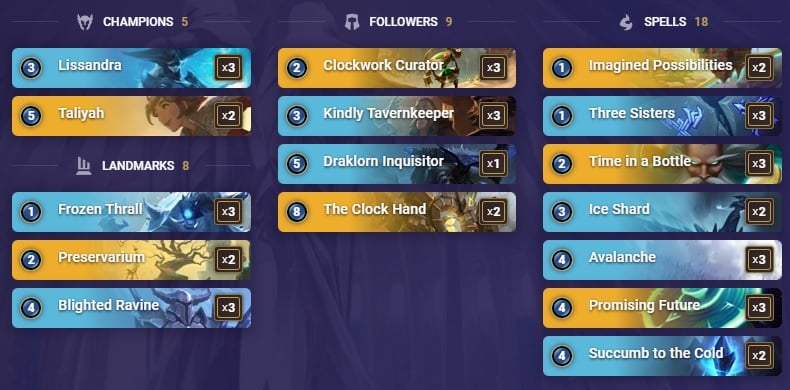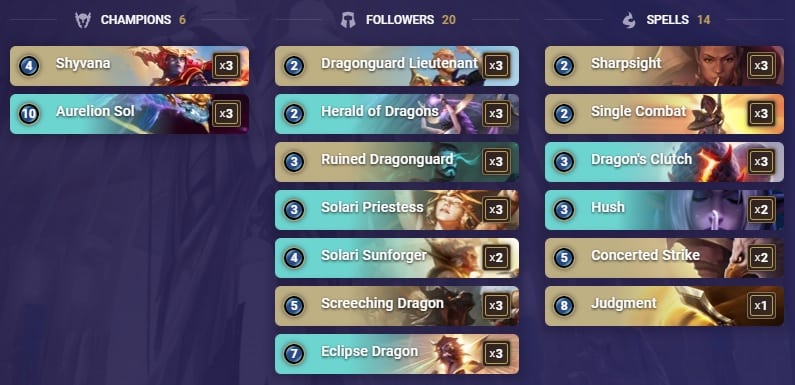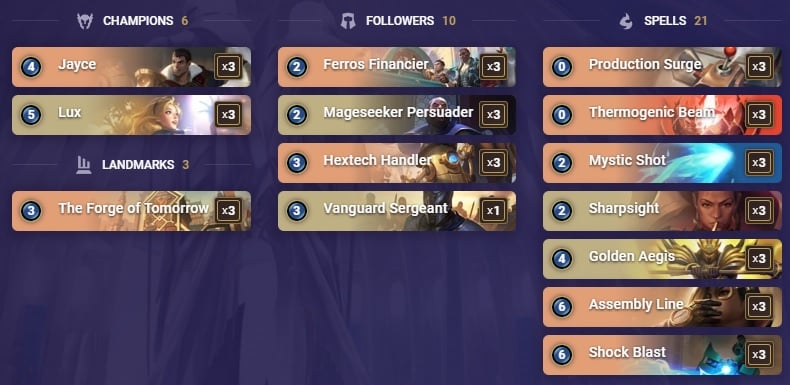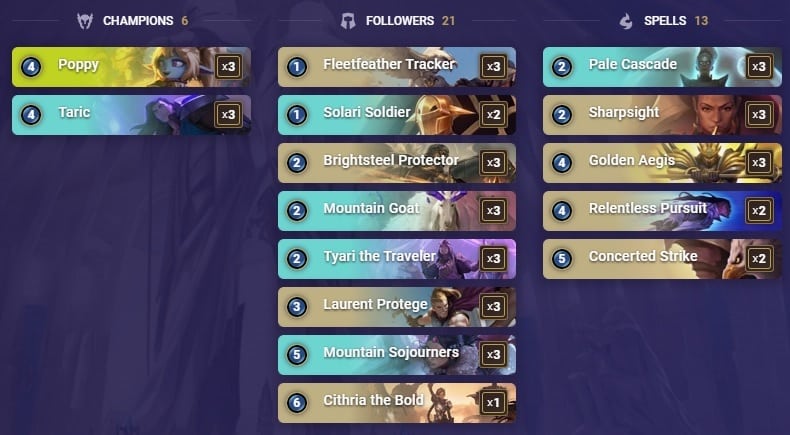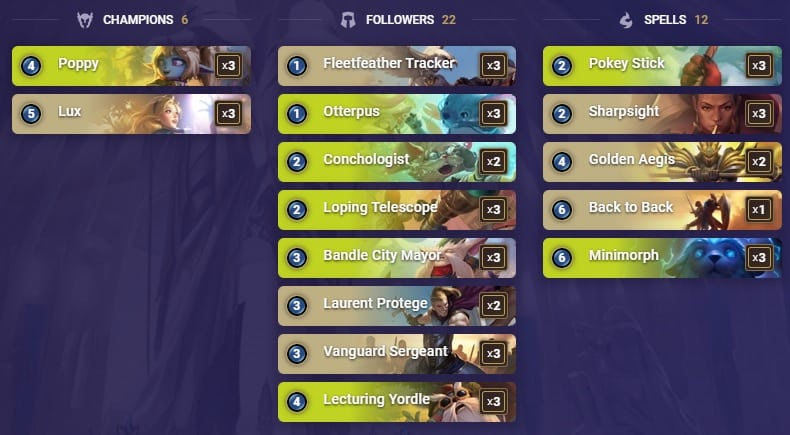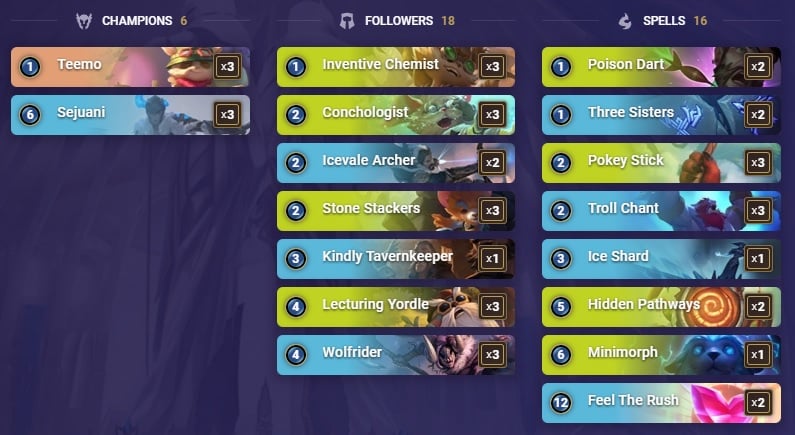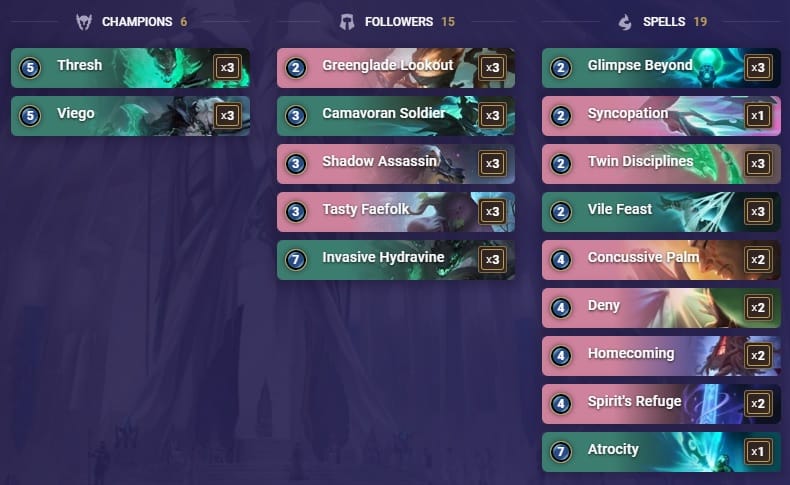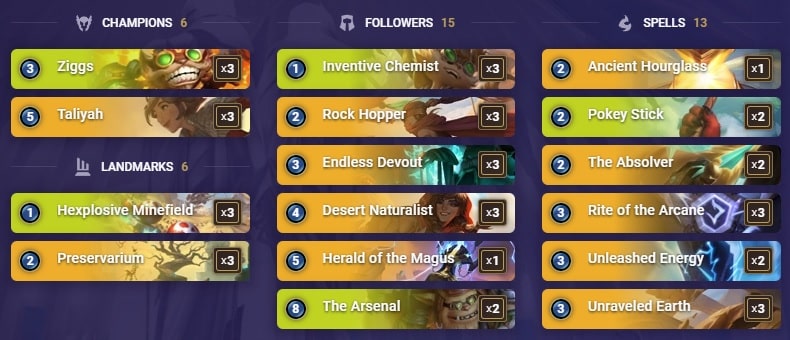After a break in proceedings, we’re back with the milestone 50th LoR meta snapshot. In this series, we discuss the decks that are part of the meta and rate them on a scale of 1 to 5 stars. We also draw conclusions regarding the current state of the game, so that you can delve into your own ranked journey with a head start.
We’re in a weird spot, with the latest patches causing some change, but not as much as players hoped for. For example, the Poppy pandemic is still in full force. Jayce is seeing some play, but the novelty seems to be wearing off, as the need to play 6-cost spells proves too high a price.
If you have any questions, feel free to drop by our Discord. Best of luck on your climb!
Graphics: WellMax81
Editing: Wusubi, Sebodunum
Writers: Ultraman, Othal

CECAOAQGBMKCAIJNHI6ACAYGBAAQIBQKAEBACAQCAECQMAIDAIDAEIRGAIAQEBQSAEBQCFQ
Difficulty: Easy
Once leveled-up, Gangplank and Sejuani are some of the biggest threats in the game. They share a level-up condition while synergizing with each other. GP’s AoE deals damage to both blockers and the Nexus, activating Sejuani’s ability and freezing the whole board. This allows you to take value-trades each and every turn while destroying the opposing Nexus.
The inclusion of Feel The Rush allows you to steal some games against slower archetypes and in the mirror - you pay a relatively cheap deck-building price for a very impactful tech card. The deck has amazing results so far in this meta, and has a balanced matchup sheet. (Write-up by Ultraman)
CECAIBIDAEDASDIEAECCMJZNGQAQIBAQAEAQGFAEAEBQIEQBAECACAICAMBQCAYDB4BACAIDEMAQKAYE
Difficulty: Easy
Despite the nerfs to Draven and Lost Soul, the deck stays on top, mainly due to its ability to both pressure and resist pressure. Let me explain: the deck is able to handle most Aggro decks, as it has a very similar curve with a stronger finisher, but it can also pressure other Midrange decks, which represent the majority of the meta at the moment.
But pressuring isn’t enough to win against Midrange decks - the real reason the deck crushes he opposition is Sion himself. He’s able to close the game out from a full life Nexus in one turn, and, if not answered properly, he often just ends the game whenever he hits the board.
For Aggro and Midrange decks, the best outcome would be to win the game before Turn 7. However, the fact that Draven-Sion has such an early curve and great tempo makes the task nearly impossible. That being said, it has some forms of weaknesses.
Minimorph and Concussive Palm can deal with Sion, and the usual anti-aggression tools (e.g. Eye of the Dragon, Vile Feast) are enough to deal with the early pressure. Still, the Noxian duo reigns supreme for now! (Write-up by Ultraman)
CEBQQBIKA4UTCRKJOSRQDJQBAMAQGAQMFABAEAYDAQAACAIBAMSQ
Difficulty: Easy
Ziggs-Poppy ended up with only Tenor of Terror nerfed, who was easily replaced by Lecturing Yordle, probably one of the best cards in the game as of now. You can keep the pressure on by playing cards each turn, while not emptying your hand due to multiple card creation options, such as Bandle City Mayor and Conchologist.
Poppy is obviously a terrible foe to face - if unanswered, the extra health and damage she’ll give to the whole board will make it difficult to value-trade. Ziggs also has a lot of HP, in fact, most of the deck’s threats have too much HP to be dealt with using the usual control tools.
The classic Burn package with Noxian Fervor and Decimate will threaten any deck that lacks healing, especially when throwing cards like Inventive Chemist, Legion Saboteur and Pokey Stick to the mix. With the usual Burn and some extra damage options, no Nexus is safe from Ziggs-Poppy! (Write-up by Ultraman)
CEDAGAIABEKR2BABAIDASDARAEBQADQBAMBAUAIEAABACBIKFEBQCAICCYAQEAAHAEBQEFABAEAQEOI
Difficulty: Moderate
Rally, Rally and Rally again! Either your opponent will be dead, or you’ll have no cards left to play. This deck holds a masterclass called “How to steal a game.” Here’s a quick look: Elusive units everywhere, Ghost on a leveled-up Zed for a double Elusive hit, multiple Rallies to capitalize on the potential lack of answers, and extra damage with Sharpsight and Twin Disciplines.
On the downside, your units are fragile, and you have to think twice about trying to protect them with combat tricks or Nopeify! If you spend too many resources on protection, you could lack the extra push when going all-in later on. This deck often refuses to fight for the board and tries to steal the game despite a total lack of board control later on.
But that doesn’t mean you’re supposed to always give up the board. It’s a question of your opening hand - Fleetfeather Tracker and Young Witch can be great early game value tools, forcing your opponent to sacrifice minions each turn, which allows you to set up your champions. There are few choices to be made, but failure isn’t an option with this deck. (Write-up by Ultraman)

CQBQCBIGAECAKCQHIVE2MAIGAIDAIGRAFU5DYAQBAUFBUAQCAYJB6AIBAQDA4
Difficulty: Easy
TF-Gangplank wants to erode the opposing Nexus, until Double Up or Gangplank finish the job. This deck wasn’t as lucky as Ziggs-Poppy when the patch hit - their options were more limited, already playing both Tenor of Terror and Lecturing Yordle.
But it was nothing a few more early game options and direct Nexus damage couldn’t fix. Stone Stackers are as strong as ever, although less absolute, especially against Biglewater’s numerous pokes. Gangplank is your main win condition, and with an earlier curve than GP-Sejuani, this deck has to get him leveled-up by Turn 5 or 6 consistently. Far from an impossible task, but given your opening hand, it could force you into some suboptimal choices.
Double Up is either amazing or terrible, as it’s hard to use against combat tricks, and many decks have some up their sleeves, especially Ionia and Demacia. Hidden Pathways is a cheap way to refill your hand and is absolutely crucial with your early curve and the lack of card creation. (Write-up by Ultraman)
CECAGAIAAYER2BIEA4KDNAABQIAYUAIBAMAA4AIEAABAEAYEA5OWPAIBAEBAAAICAECAODIBAQAAG
Difficulty: Moderate
Akshan is the primary win condition, and keeping him alive should be your biggest concern. The many combat tricks at your disposal serve that purpose, while First Strike allows you to take value trades simultaneously. Brightsteel Protector is useful to stop your opponent’s attacks, as it’ll both fasten Akshan’s level-up and cost them a unit.
The classic Demacia shenanigans still happen, such as Fleetfeather Tracker value-trading thanks to Barrier, or Single Combat and Coordinated Strike value-trading multiple threats. Your Rally is to be used a bit differently than in classic Demacia decks, since it often won’t result in winning you the game, and the Barrier can be used defensively, or to level-up Akshan.
Vekauran Bruiser is great to block opponents, and adding potential keywords onto Sivir is wonderful, as her level-up is quite easy to reach, and will spread those keywords along the whole board. The Absolver is active most of the time due to Akshan, and can be used prior to Sivir’s level-up, either to protect your units, or just as a way to get Sivir to level-up during the attack, activating her ability for the remaining attackers! (Write-up by Ultraman)
CEBQCAQGFYDQKCRJOSCADJQBU4A26AOCAEAQCAZXAMAQEAYJAEAQGLQCAUFADGABAICAKCQ2N6QADRQBAEBQGDI
Difficulty: Moderate
The swarm of Yordles will feed The Bandle Tree until the opposing Nexus explodes! I mean, on paper, at least. The deck’s ability to apply pressure seems to be more relevant this patch, as the many minions force your opponent to delay their win conditions in order to stay alive.
Meanwhile, your win con progresses by you adding more pressure onto the board. Still, it’s not enough to deal the final blow most of the time, but with Bandle City Mayor’s swarm abilities and Poppy’s buffs, you can push the opponent into a bad spot, where they can’t pressure you without risking to die, and thus, can only watch as you fulfil Bandle Tree’s condition.
Minimorph is obviously necessary against Sion or Lee Sin, and Buster Shot is great at answering Poppy. Pokey Stick allows you to activate Scorched Earth or Ravenous Flock, dealing with the more traditional threats where Minimorph would’ve been too expensive to use. (Write-up by Ultraman)
CEBQOBIKAQYTSXK6MKTACAIBAUUAEBIFBAEQCAYFBIARVUIBAMAQIBJYAIAQKFA5AECQKCQ
Difficulty: Hard
Darkness still roams this earth, as Veigar and his evil minions haven’t surrendered. Despite a poor matchup into Demacia, Lurk and combo decks, Darkness stays reliable mainly as a counter. The deck is more successful in a tourney setting, where it’s able to stop the Draven-Sion powerhouse, but also fares well against Ziggs-Poppy, TF-Gangplank and Lee Sin.
With Minimorph handling the bigger threats, such as Sion or Lee, the deck mostly suffers during the early game, where you’ll have to make efficient choices to deal with the right threats, or you’ll be crushed under the pressure. This means accepting a number of damage, and not just removing everything that hits the board.
You don’t have enough mana to deal with everything, so you need to accept losing the board for a few turns. That’s usually where mistakes happen - taking too many risks will kill you, but not taking enough risks will also get you killed.
This is the deck’s main difficulty spike. Once you get through the early game and buff Darkness up to 3 or 4, you’ll be able to start taking the board back, as your late game destroys most other decks at the moment. (Write-up by Ultraman)
CEBQIAYJBERTHVYBAUBAEAYFAYEASAIBAIGAGAIDAIKACAYJDMAQCARRAMBAGCKVMAAQCAQCAECAEFA
Difficulty: Hard
Zoe-Lee is one of the hardest decks to play in the history of the game. Especially now that Minimorph and Aloof Travelers can deal with your win con easily. Eye of the Dragon is the deck’s best card, and will win you the game against most Aggro decks.
Demacian decks are the main problem for you, as they can attack multiple times a turn, not allowing a refresh of your angry lifesteal dragon. First Strike won’t allow you any healing and Elusives will deal damage out of your dragon’s range.
You’re not a fan of facing Zed-Poppy, but on the plus side, Ziggs-Poppy and Draven-Sion are easy to deal with, Concussive Palm being an amazing tool to stop both Poppy and Sion from attacking. The Bandle Tree and Darkness are the two decks you truly want to avoid, as Aloof Travelers and Minimorph are literally impossible to outplay.
Add to that whole mix the fact that you’re a combo deck! Get your calculator out, it’s time to find the lethal. This might seem laughable, as counting to 20 is no hard task, but watch out, sometimes you’ll be too caught up in trying to survive to see that you can actually kill your opponent. (Write-up by Ultraman)
CECAIAQDAEDQQCIBAECAQBAFBIYULJQBV4AQCAIDFYBQEBIKDKSACAIBAM3QCAYDBUAQEAIDCYZQ
Difficulty: Moderate
Yes, it’s real - Teemo-Swain made it to the grand stage! Daddy’s finally back, I was so sad when he left to get milk, months ago. Apparently, he got confused and bought some mushrooms instead! This deck abuses Lecturing Yordle, with Teemo adding an extra layer of direct Nexus damage, which in turn helps with Swain’s level-up.
Swain is a major threat with his level-up effect, dealing extra damage to the Nexus and the opposing board, especially with the amount of poke helping him stun the entire board whenever he wants. By the way, we aren’t so easy to bribe. Naming a card “The Leviathan” won’t get the deck any higher in the meta snapshot, sorry.
Swain’s boat is expensive with its 8 mana cost, but coupled with Ravenous Flock and Pokey Stick or Poison Dart, you can both force a removal while not losing too much tempo, and it grants you an extra Swain draw.
The ability to refill your hand is what makes the main difference compared to the old Swain archetypes - Bandle City gives you tons of card draw, so you don’t run out of options too early in the game, and can maintain pressure from Turn 1 to 10.
Being one of the rare users of Ravenous Flock, Teemo-Swain has a nice matchup into most Demacian decks, and can hold its ground against Aggro. (Write-up by Ultraman)
CEDQEAIABEOQGAQAAIDQUAIFAYAQCAYABYAQEBQWAECAAAQBAUFCSAYBAQAAOAQBAADDGAICAY7ACAQBAAFSK
Difficulty: Easy
In a rather surprising turn of events, Poppy is everywhere! But rather than reducing the options available, she makes forgotten archetypes good enough to find their place in the meta. It’s been a long time since Scouts were included in our snapshot, but here they are, mainly thanks to Poppy, but also due to the disappearance of Ezreal-Draven.
With Poppy allowing you to ditch the Allegiance, you can utilize Bilgewater’s swarm cards. The inclusion of Marai Warden and Island Navigator makes the deck more balanced, able to recover from having its board handled once or twice a game.
The curve is heavier than usual, with multiple Turn 6 win cons and a wider board. As such, it’s harder to block against this deck, which translates into the opponent losing more HP, allowing you to threaten lethal faster, and force them into suboptimal plays to stay alive or play around your Rallies.
There are fewer answers in the meta, but watch out for Swain, as Ravenous Flock is your archenemy. (Write-up by Ultraman)
CMBAKBAGAEBAGBIPAYCAOAITIFCEUUACAECAMBYCAQDRMRIBAECAOOY
Difficulty: Moderate
A roar sounded over the mountains of Demacia as the dragons woke up from their slumber. It was filled with hope and a thirst for greatness yet unearned. All across Runeterra it went, carried by the icy winds of Freljord, echoing in the vastness of Noxus, and south it kept on, reaching the heights of Targon and the ocean of sand in Shurima.
There, something stirred, buried deep in the ground, hearing the call of a would-be Alpha Predator. There was an awakening, from the ocean of sand to the sea of water and salt in Bilgewater. Kindred spirits woke up and as soon as the dragons tried to take to the sky, they realized they weren’t at the top of the food chain.
Lurk is a great archetype when you want to apply early game pressure, and when the meta is low on AoE spells like Avalanche and Withering Wail. Lurkers compensate for their high Power stat and low-cost units by having a lower-than-average Health, but that doesn’t matter in the matchup against dragons.
Demacia only has access to combat tricks as removals, which means they’ll need to kill their own unit to remove one of yours. Lurkers can play the same game as Demacia, with ways to apply Vulnerable or strike an enemy with a Bone Skewer in answer to a Concerted Strike or a Single Combat.
Against other Demacia-centric decks like Zed-Poppy, your units help with trading for advantageous blocks, and a leveled-up Pyke can clear a full board with no way to counter him if played as a spell. While the pressure you can produce is unrelenting, slowing down can also be an option thanks to Jaull-fish, a powerful board-clear tool when paired with a board full of Lurkers.
While the deck may seem high-rolly and dependent on whether you’ll be able to proc your Lurk, it’s a deck that needs a lot of planning and practice. You’ll need to ask yourself the right questions: should you attack even when you’re not sure of Lurking? Should you drop this Rek’Sai as a defense tool just this turn, even if she returns to your deck afterwards? Should you play with your food or go for the throat? (Write-up by Othal)

CMBQEAIBCQZAGBAHD4WEEBAEAEAQKCQOAIBAIAIJBMCAIBYNEJEXQAIBAQAQM
Difficulty: Hard
Thralls made their official comeback during last season, when brought into EU Masters out of nowhere. While excellent in that specific format, ladder has been less kind to it, as Aggro decks profit from its limited healing options and the slow game plan.
Demacia can also prove to be very challenging, as combat tricks usually save most units from Avalanche, and your only way out of early game aggression is a desperate rush through your Landmark’s countdowns and Blighted Ravine. Despite those glaring weaknesses, the deck can still hold onto its synergy, focusing on leveling-up Lissandra and summoning giant frozen Thralls to finish the opposing Nexus.
Similarly to other combo decks, you have to go down the risky road and give up the board in order to set up. While you don’t have enough control to handle the opposing win conditions, your own win con is strong, and if you’re greedy enough, it might be better than your opponent’s! (Write-up by Ultraman)
CICACAIADIAQIAAUAQBQABQIBMHAKAYJAMHFOYDEAIAQEAABAIBQSOKVAEAQCAAH
Difficulty: Easy
Dragons received some buffs, making them good enough to include in our snapshot. Yeah, it isn’t the impressive Dragon deck everybody hoped for, but listen, we take what Runeterra gives us! The deck can hold its ground against some threats, and its late game potential is impressive - ASol is a great finisher, and an easier level-up means closing games out faster.
But the main problem is the deck’s inability to pressure the opponent, while also lacking proper tools to handle aggression and deal with crucial threats. With low tempo and expensive answers, you’ll always run behind, forcing you to take a risky approach, such as going down to 0 mana, hoping your opponent lacks a combat trick to counter your whole turn.
The deck can high-roll pretty hard, and performs well against decks with conventional win conditions. (Write-up by Ultraman)
CEDACAYABYAQIAACAECAIDQCAEACQKQCAECBWNAGAUCBKFQYDINR2AABAEAQABQ
Difficulty: Moderate
Jayce found his way into the hearts of LoR players as easily as into the people of Piltover. To put it bluntly, however, he sucks, and his builds (although popular) are stuck in the low tiers.
His abilities are powerful, so what’s the issue? Why do his decks struggle so much despite having a powerhouse of a win con? Well, it’s purely due to the fact that most of the 6+ mana spells are awful. Even the newer ones that are slightly better are still underwhelming and it’s hard playing them without feeling contrived, either by their high cost or their Slow speed.
Anyway, Jayce on his own is a decent win con, and Lux is always happy to give you enough time for Jayce to level-up, but in order to truly perform, you need to be flexible and consistent. This is something that a deck focused on slow and expensive mechanics will always struggle with.
Let’s hope that one day, Jayce will get the ability to make his spells Fast, just like Senna! (Write-up by Ultraman)
CQCQCAYABYAQIAACAECQUKIDAEAASCY5AUBQSIZ2I5IVYAYBAEABKAICAAAQCAYJLAAQCAIAGM
Difficulty: Hard
Similarly to Lulu-Jinx back in the day, a deck that used to be a meme became a respectable archetype this patch, when its whole game plan can suddenly rely on 6 win conditions instead of 3. Having 6 Rallies functioning with Taric helps the deck immensely, and while the combo stays a bit shaky, at least now it happens often enough to have a decent win rate.
But in order to win, you rely on your opponent not being able to either answer Taric directly or kill him when blocking. As such, you need a lot of setup in order to have enough mana to play everything while protecting the embodiment of beauty himself. Poppy has solid synergy with Rallies and with Taric, as they both profit from Barriers and buffs. (Write-up by Ultraman)
CQBQCAYABYBQCAAGDUVAOBIKAECCSRLUUYA26AIDAEAQACYBAQAAEAIFBIYQCAIBAAUQ
Difficulty: Moderate
Bandle City and Poppy somehow make this deck viable, despite its clear lack of synergy. While it tries to benefit from Lux and her buffs, in the end it’s Bandle City doing Bandle things, such as keeping full mana while dealing with threats, swarming the board for free and creating infite value through card generation.
Lux has some utility, but can often be underwhelming - she won’t find much help in this deck, so she’ll only perform against opponents who lack direct answers. Despite all of its flaws, this deck is probably the best Lux deck around - it’s not much, but we got your back, Lux fans. (Write-up by Ultraman)
CECAKBIKA4YUKSNGAEAQCBAIAEBQCAQCAIAQECIEAICQUGVEAEAQIAIKAEAQCCYBAMARMAYBAQAQSAIBAEZACBIKAE
Difficulty: Moderate
Sejuani is an amazing win condition, and as such, helps out dear Teemo to get a respectable win rate. But once again, this is a Bandle City abuse deck at heart. Feel the Rush is an amazing card, especially in a deck that’s able to ramp up some mana, and that’s enough to keep the deck afloat.
Watch as your 10/10 Teemo obliterates your opponent’s Nexus on Turn 8... Every now and then. But when it happens, it’s so cool! The classic game plan also functions well, as Sejuani’s defensive abilities are obviously really good, so she might be able to grant you enough time to stabilize and win by eroding the opposing Nexus. (Write-up by Ultraman)
CECACAYCBEBQCAQMEQ4QGAIFFAYTIAYEAU2TMNYDAEBAEBIBAMBAKAQBAISTCAQBAECRSAIEAIDQ
Difficulty: Moderate
This deck lacks synergy, which is something Viego has mastered since his arrival in the game. But despite the poor cooperation between the champions, they’re a force to be reckoned with, or at least Viego is. Greenglade Lookout is a good way to reduce Viego’s or Invasive Hydravine’s cost in order to finally have a good curve.
Ionia’s multiple ways of stalling the game will prove useful, as Viego needs to scale first before finally having some impact on the game. Once buffed up, he’ll be difficult to remove cheaply, and Ionia will punish any attempt at a more expensive solution. But that doesn’t really solve the Minimorph or Aloof Travelers problem. Honestly, nothing does.
You hope not to face any decks with these cards, or that you’ll have enough pressure to punish your opponent for using that much mana to answer relatively cheap threats. Clearly, you won’t have enough board presence to do that, but hey, if you want to play a Viego deck, you have to be a believer! (Write-up by Ultraman)
CQBQEBIHA4FQGBIKDNE2GAIFAQDQ2JJGJFMQGAIEA6FACAIFA4CAEBIKA2TACAQBAQDUYAIFA4IQ
Difficulty: Hard
Landmark archetypes have proven to be both difficult to pilot and to get results with. This is no exception, since most of your actions will need to be carefully planned in order to be functional. But if you succeed, you’ll find yourself with a powerful deck, able to pressure most archetypes in the current meta.
However, the deck can’t handle being pressured. That’s the main problem - landmarks are costly and you don’t have any utility, so most of the time you won’t be able to compensate for the loss of tempo. That being said, Ziggs and Taliyah are threatening damage dealers, and The Arsenal is a crazy win con! With sometimes 10+ keywords including SpellShield, you’re sure to nuke the opposing Nexus.
Your opponent could of course answer The Arsenal with 2 spells, but still, if used in a short period of time, no deck in the game will be able to deal with all of your threats. Since you can deal a lot of direct Nexus damage, one slower turn will often be your oppoent’s undoing. (Write-up by Ultraman)

